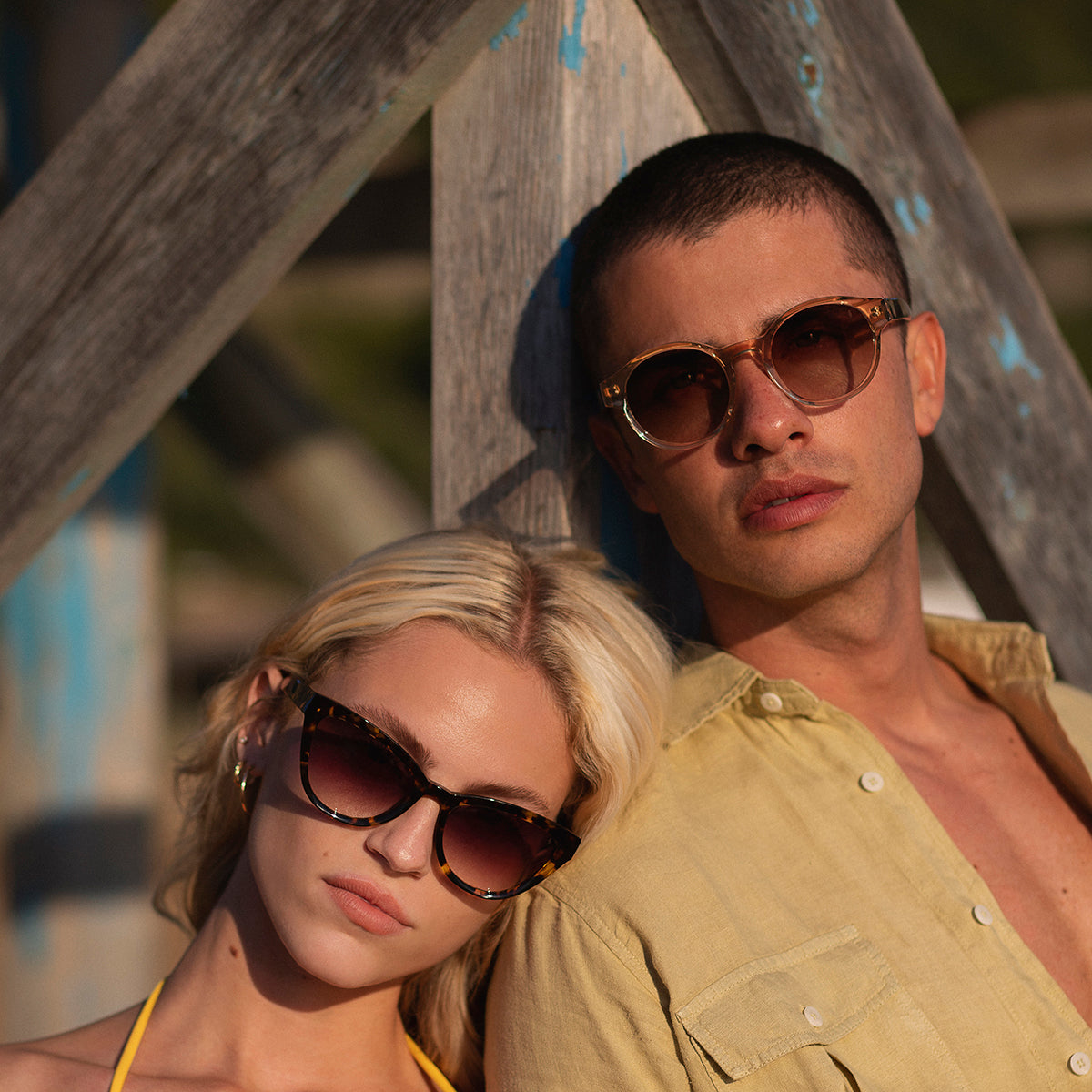Adventures in Morocco

Sundays are on your terms, in your time. Here we catch up with a different weekend warrior every week to hear where they go and what they do with their Sundays.
This week it’s writer Zara Miller and photographer Adrian Morris taking us along on their slow-moving, mint tea-drinking, people-watching, day-dreaming adventure through Morocco, where every day feels like Sunday.
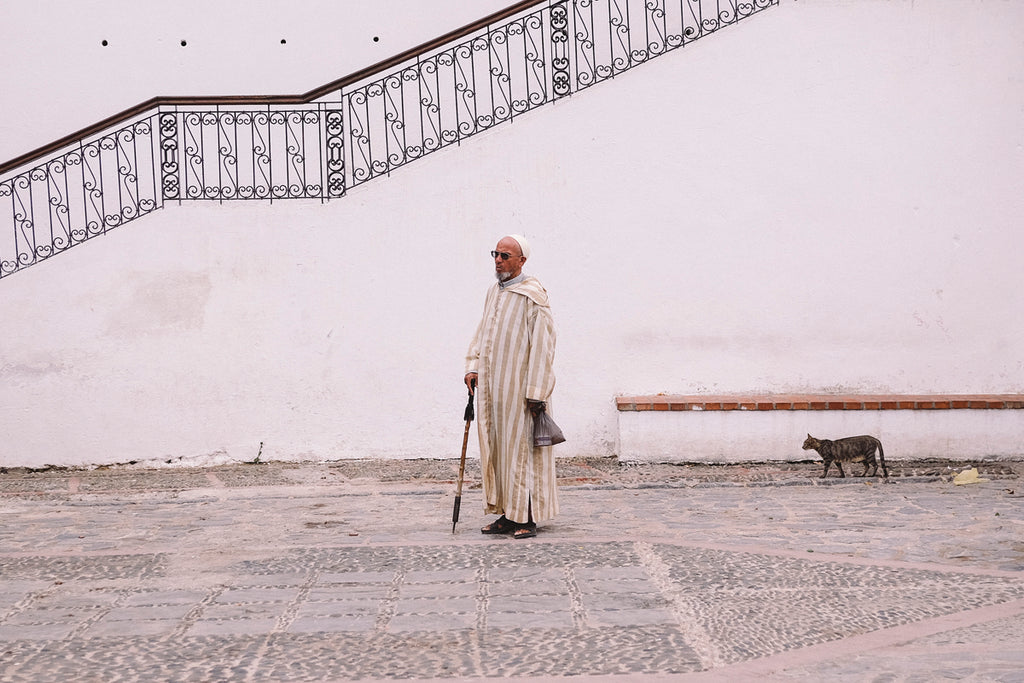
We travelled through canary melon fields and wound up mountain roads, we drank mint tea in the medina and read our books beside camels, we swam in the puddle of a waterfall and returned in the evening to eat fish tagines for dinner. A week in Morocco was never going to be enough. By the end of the trip I had to drag myself away from the mystical lure of Tangier’s Kasbah, but our self-made route through Morocco’s most north-easterly tip turned out to be an ideal one to take this time of year.
DAY ONE
RABAT
My plane landed in Rabat-Salé at ten thirty at night. After catching a taxi vert with heavy eyelids and an agreed price of 150 dirham I followed the driver’s sandaled footsteps through a maze of tall alleyways past a domino of doors that seemed to close every time I tried to see inside them. The owner of The Repose – a luxury riad hidden amongst Salé’s ancient medina – greeted me at the door with her baby boy on her hip and told me dinner would be ready when I was. Jan had picked her Arabian Suite for my short stay; decorated in rich crimsons and Phonecian purples, a genie’s golden lamp on the shelf and flower petals on the bed, it was a room fit for a princess. This princess dumped her backpack, washed her dirty hands with the beldi soap in the bowl and hurried hungrily to the roof for a deliciously authentic candle-lit vegetarian meal served with a pot of sweet hibiscus tea. I drank every last sweet drop and headed to bed beat and excited for the week’s adventures.
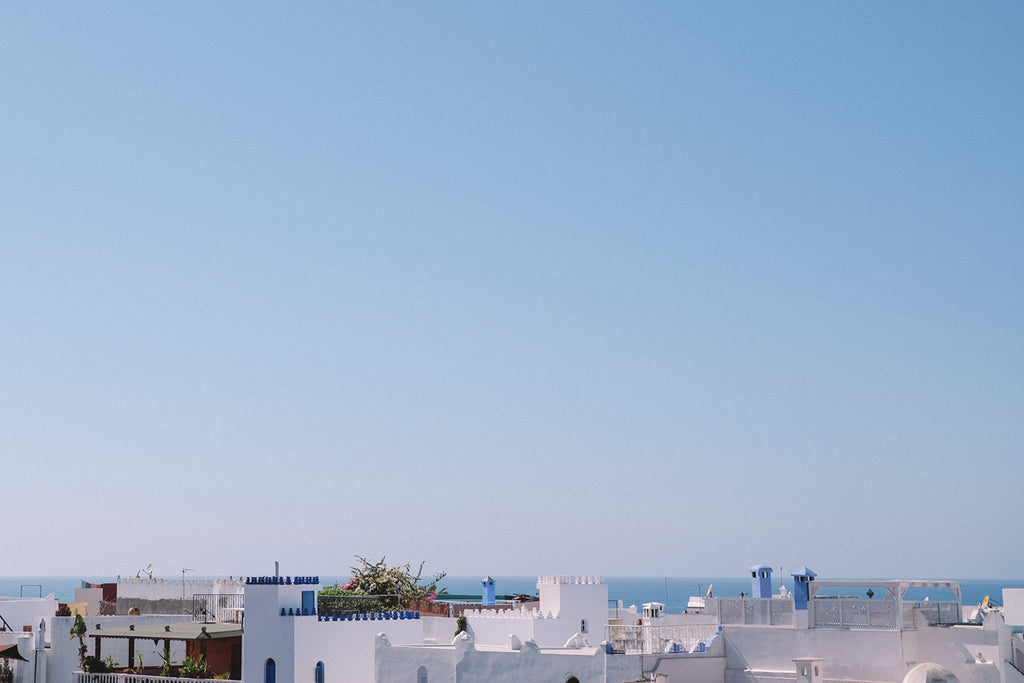
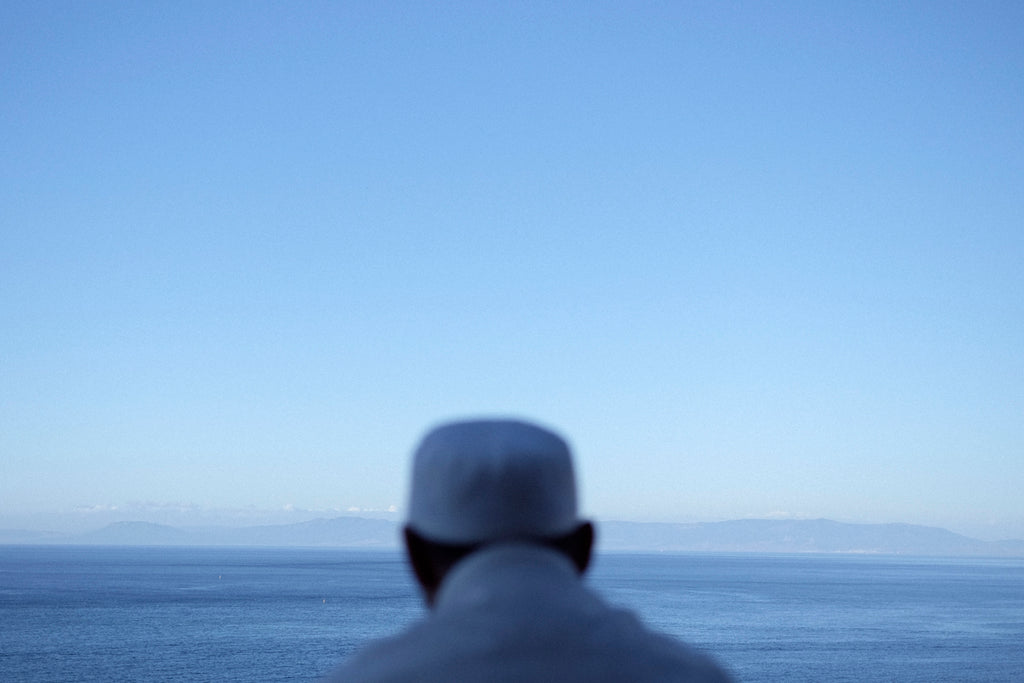
DAY TWO
RABAT → ASILAH
The train from Rabat-Salé to Asilah left the station at 10.30 ferrying me four hours north past hundreds of sun-baked mud fields. I sat by one of the wide windows watching the trees wave the hands of their palms in the late summer wind. Passengers came and went through sliding carriage doors. Farms sown with hundreds of canary melon seeds began to multiply and speckle the brown land with their bright yellow peel. A man stood in a barren field amongst eight white herons holding the tip of his baseball cap to the sun. The taste of dates from breakfast still lingered in my mouth and the scent of time seemed to carry on the wind.
I would highly recommend travelling by train in this part of Morocco (my ticket cost 100dh and timetables can be found at oncf.ma), especially to those prone to excessive-daydreaming the old benched carriages make you feel like a character from The Sheltering Sky until the landscape brings you back down to planet earth. Beside a vacant building site a child squatted barefoot prodding a small fire with a stick drifting smoke above the head of his mother waving her hand at a tree, upwards, to where another child’s foot lay dangling. The train slowed as we rode past a long stretch of camel-coloured beach and finally pulled into Asilah station.


For 10dh a grand taxi took me and two others (passengers picked up along the way, as most grand taxis tend to do) to meet Adrian at the guesthouse Dar Azaouia where we would be staying for the following two nights. That afternoon we walked through the medina and down to the local beach stopping to sit where the sea shampooed the rocks. We drank brown bottles of Casablancas (Moroccan beer, not the easiest thing to come across in an Islamic country) and sat with veiled strangers amongst the huge rocks to watch a fluorescent sun drop into the ocean. Scrawny cats sitting with their backs to the setting sun searched for glimpses of dinner moving between the cracks, alert as hungry little sphinxes. When the night finally fell we went in search of a cheap fish tagine for dinner; a tradition we would not break over the next six nights.

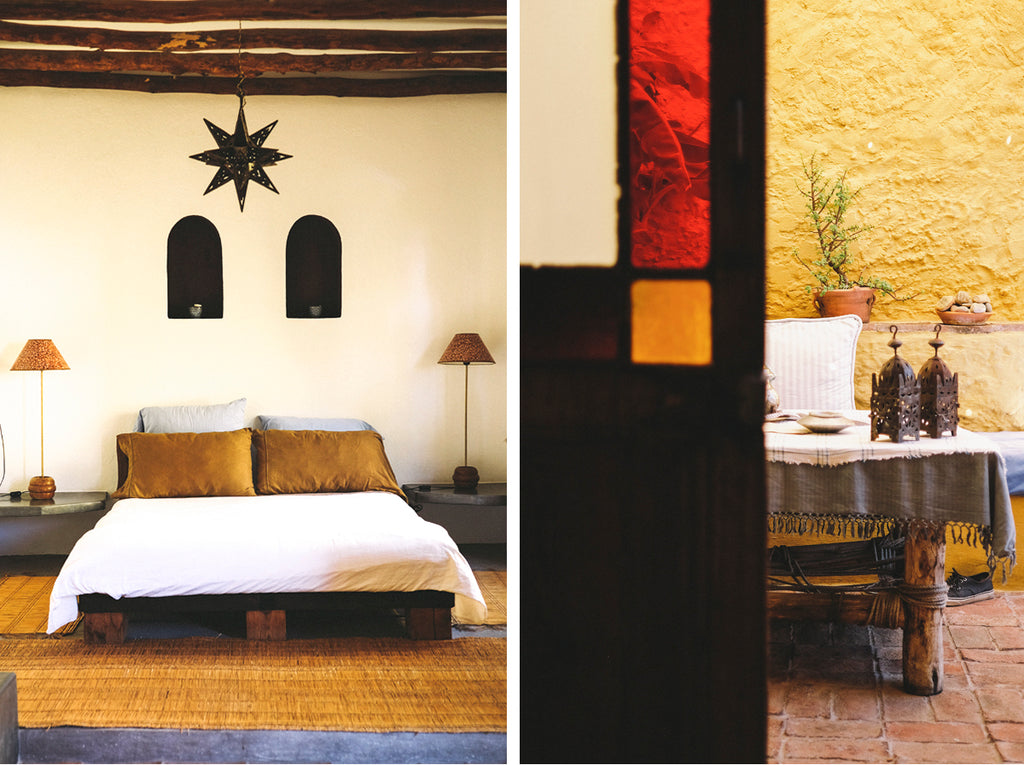
DAY THREE
ASILAH
The next morning a strange mist fell over Asilah like a milky white pall. After a delicious breakfast prepared by Caroline at Dar Azaouia, including fresh watermelon juice, eucalyptus honey and pancakes, we went exploring only to find ourselves walking into the eye of a sandstorm that was curdling along the coast. Nothing seemed to separate the sea from the sand the sand from the sky or the sky from the sea again. Women dressed in black burqas passed us through the thickening mist like the black sails of ships expanding in the wind. A plastic table with a dusty red parasol stood waiting for two invisible customers. As we walked further along Plage de Asilah we came to a clearing where a football match was taking place, a white ball battling through the mist, and I wondered how the players were not just kicking air. We stopped beside four resting camels and, after convincing their owner we did not wish to ride their cushioned humps, sat to read our books. The camels grunted eerily from the death metal depths of their bellies and the mist continued to stretch either side of us. My immediate reality seemed more fictional than anything between the pages.
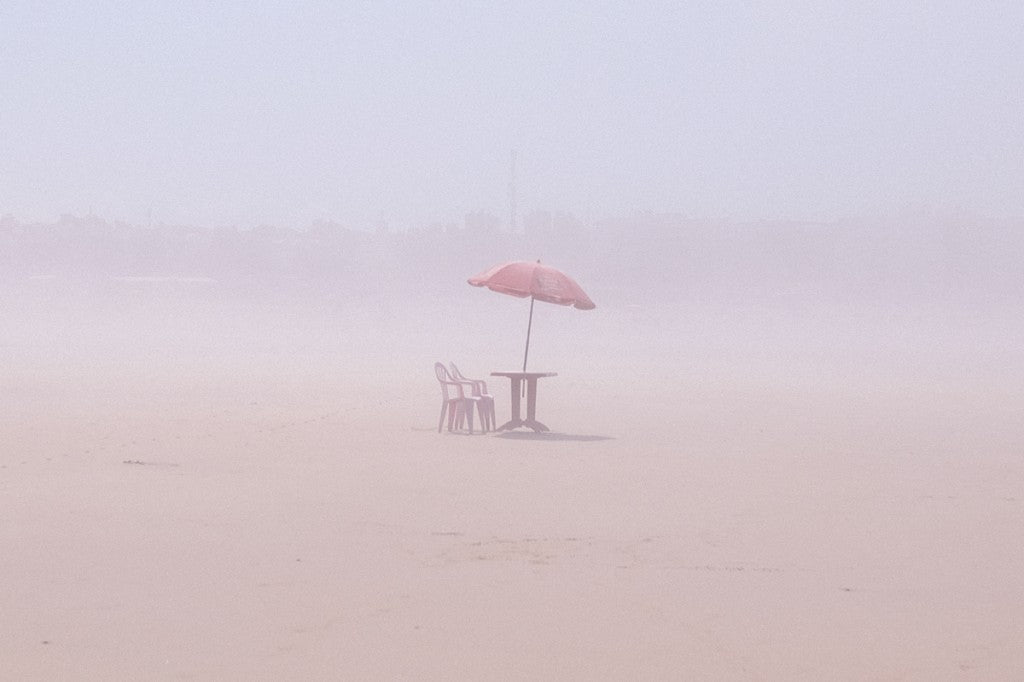

The art from the previous month’s annual art festival remains on the walls in Asilah but September does not seem to attract as many tourists. This is in many ways a blessing but also at times felt something like a curse. That day on the beach, long uninhibited stares lingered on us as though we were foreign sea creatures that had washed up on shore. Particularly under the hexing eyes of the veiled females that passed, our exposed and tattooed skin seemed to turn to scales. I made a mental note to cover up more the next day. We left the beach to go shopping for fish in the market and I cooked dinner in a tagine for the first time in my life. A simple recipe of sardines, sliced tomatoes, garlic, chilli, lemon and dates cooked in a tagine for about twenty minutes costs less than 10dhm (80p) using ingredients from the local market along Avenue Imam Assili (less than a five minute walk from Dar Azaouia) and is a most tasty fish dish. There is even one liquor store on Avenue Mohammed V where you can buy a bottle of Moroccan wine.

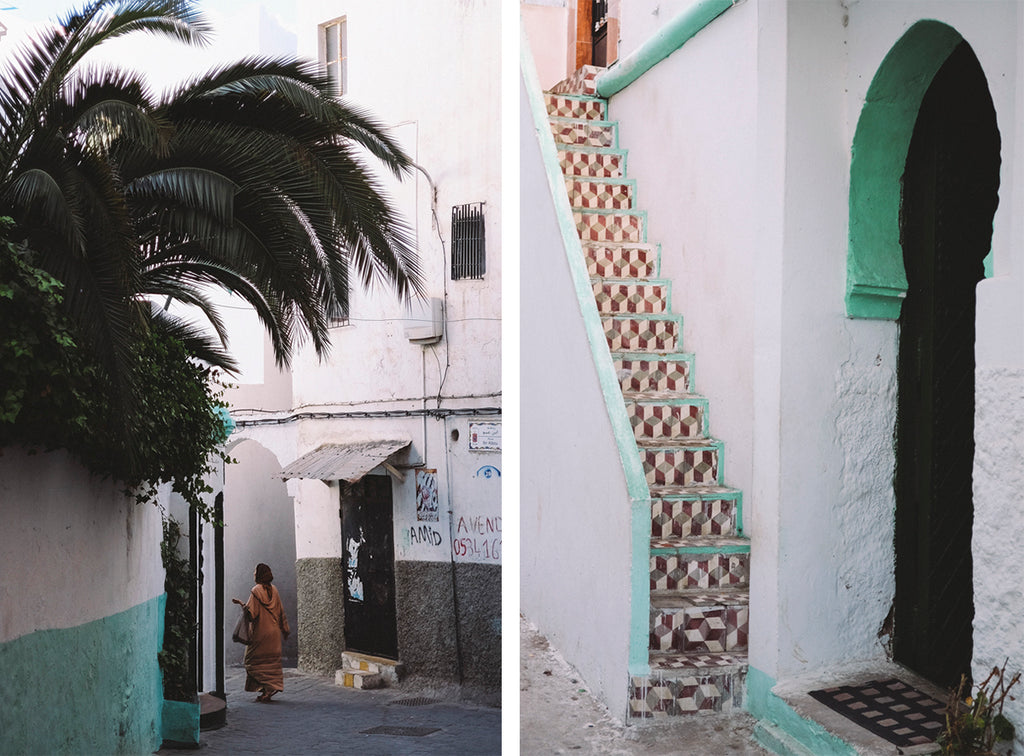
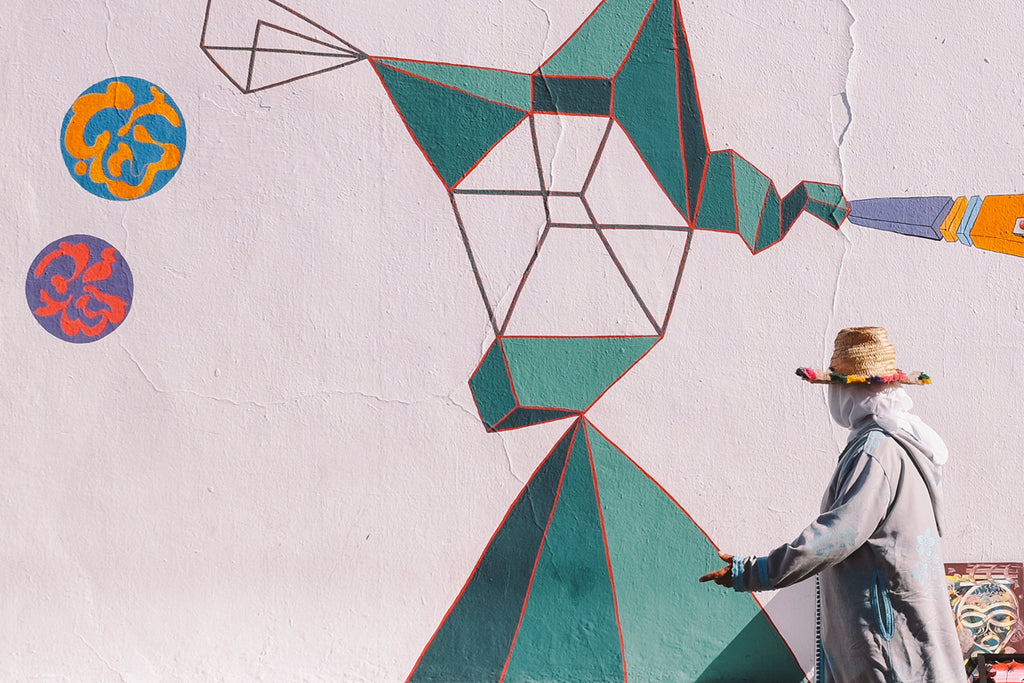
DAY FOUR
ASILAH → CHEFCHOUEN (via Ksar el-Kebir via Asilah again via Tangier)
In the morning we packed our bags and went to the mosaic café on Avenue Imam Assili. 6dh buys you a cup of sweet mint tea and a people-watching experience like no other. The totally turquoise interior was more attractive than the mint leaves darkening in our cups and we sat in near silence watching local men chain smoke with eyes glued upwards to a television set playing Harry Potter with French and Arabic subtitles. The owner of the café was the friendliest local I had the pleasure to meet in Morocco and, though we did not understand each others words, he clutched his hands to his heart with a smile as I said merci for the tea and au revoir.
We missed our train, caught a second train an hour the wrong way and when we finally reached Tangier on the third train it was getting dark. The next bus to Chefchaouen (where we were in fact headed) did not leave for another three hours. A crowd gathered in the middle of the bus station around two men having a fight over something so outrageous that one of them started pulling his shirt up off his own back. The men roared and I met the eyes of another woman sat against a tall pillar with the round face of a child asleep in her arms. We left the station and a swarm of taxi drivers gathered around us like moths to foreigners. One of the more relentless eventually broke us with the offer of a very good price and, after a couple of hours in a car with no seat belts and a detachable window handle we reached the base of the Rif Mountains where women at the roadside sell melons, apples and long necklaces of white onions.
As the taxi continued to wind up the mountain at sunset the driver was forced to swerve to the right to avoid a man crouched in a ball in the middle of the road. The man did not seem to have been hit but lay there nonetheless, unwounded, curled like a hedgehog in human clothing. It was one of the strangest things I’ve ever witnessed – the man had not been hit but seemed to have simply decided to stop there and have a lie down, like a character in a Radiohead video. The car in front had already stopped to frown, so we carried on up the mountain, turning around in our seats to watch the hedgehog man grow smaller and smaller in the rear window. The blue-washed city of Chefchaouen grew closer as night fell.
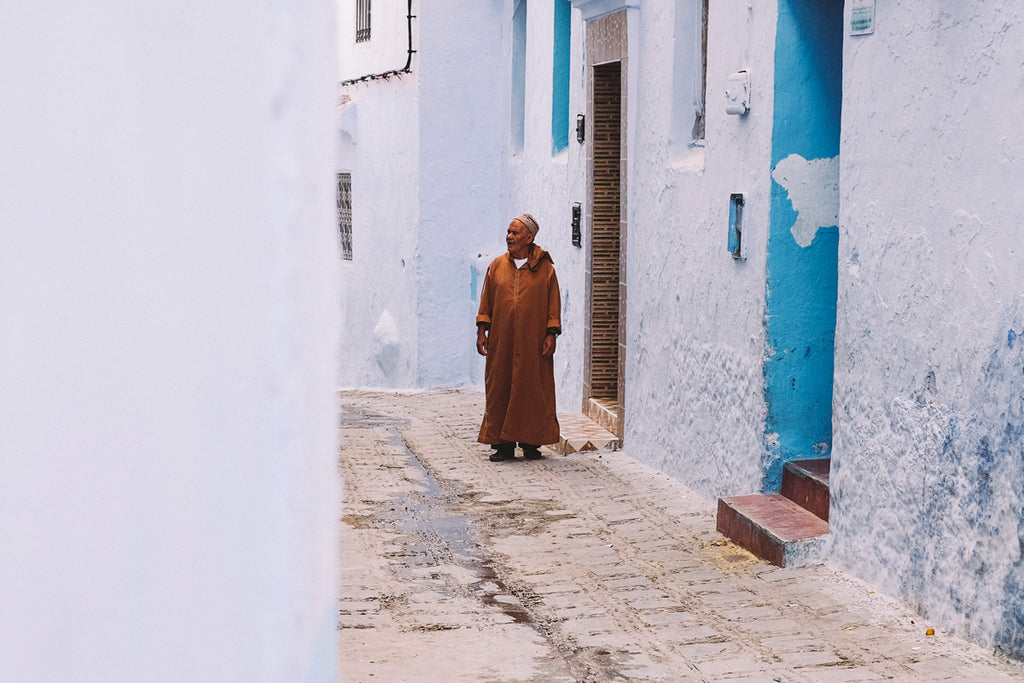


DAY FOUR
ASILAH → CHEFCHOUEN (via Ksar el-Kebir via Asilah again via Tangier)
In the morning we packed our bags and went to the mosaic café on Avenue Imam Assili. 6dh buys you a cup of sweet mint tea and a people-watching experience like no other. The totally turquoise interior was more attractive than the mint leaves darkening in our cups and we sat in near silence watching local men chain smoke with eyes glued upwards to a television set playing Harry Potter with French and Arabic subtitles. The owner of the café was the friendliest local I had the pleasure to meet in Morocco and, though we did not understand each others words, he clutched his hands to his heart with a smile as I said merci for the tea and au revoir.
We missed our train, caught a second train an hour the wrong way and when we finally reached Tangier on the third train it was getting dark. The next bus to Chefchaouen (where we were in fact headed) did not leave for another three hours. A crowd gathered in the middle of the bus station around two men having a fight over something so outrageous that one of them started pulling his shirt up off his own back. The men roared and I met the eyes of another woman sat against a tall pillar with the round face of a child asleep in her arms. We left the station and a swarm of taxi drivers gathered around us like moths to foreigners. One of the more relentless eventually broke us with the offer of a very good price and, after a couple of hours in a car with no seat belts and a detachable window handle we reached the base of the Rif Mountains where women at the roadside sell melons, apples and long necklaces of white onions.
As the taxi continued to wind up the mountain at sunset the driver was forced to swerve to the right to avoid a man crouched in a ball in the middle of the road. The man did not seem to have been hit but lay there nonetheless, unwounded, curled like a hedgehog in human clothing. It was one of the strangest things I’ve ever witnessed – the man had not been hit but seemed to have simply decided to stop there and have a lie down, like a character in a Radiohead video. The car in front had already stopped to frown, so we carried on up the mountain, turning around in our seats to watch the hedgehog man grow smaller and smaller in the rear window. The blue-washed city of Chefchaouen grew closer as night fell.

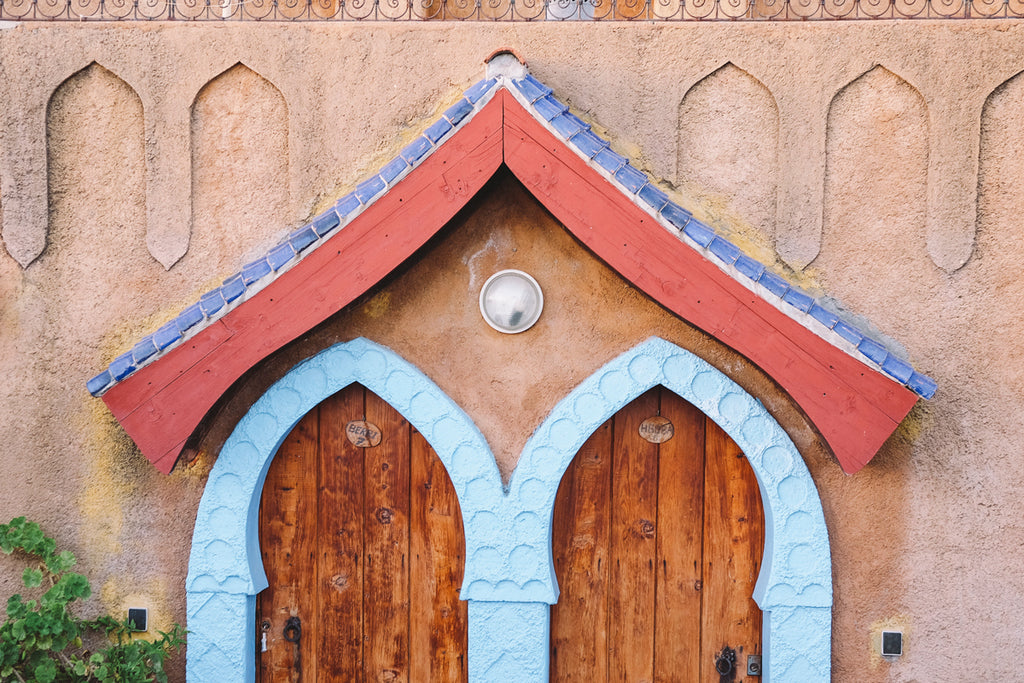
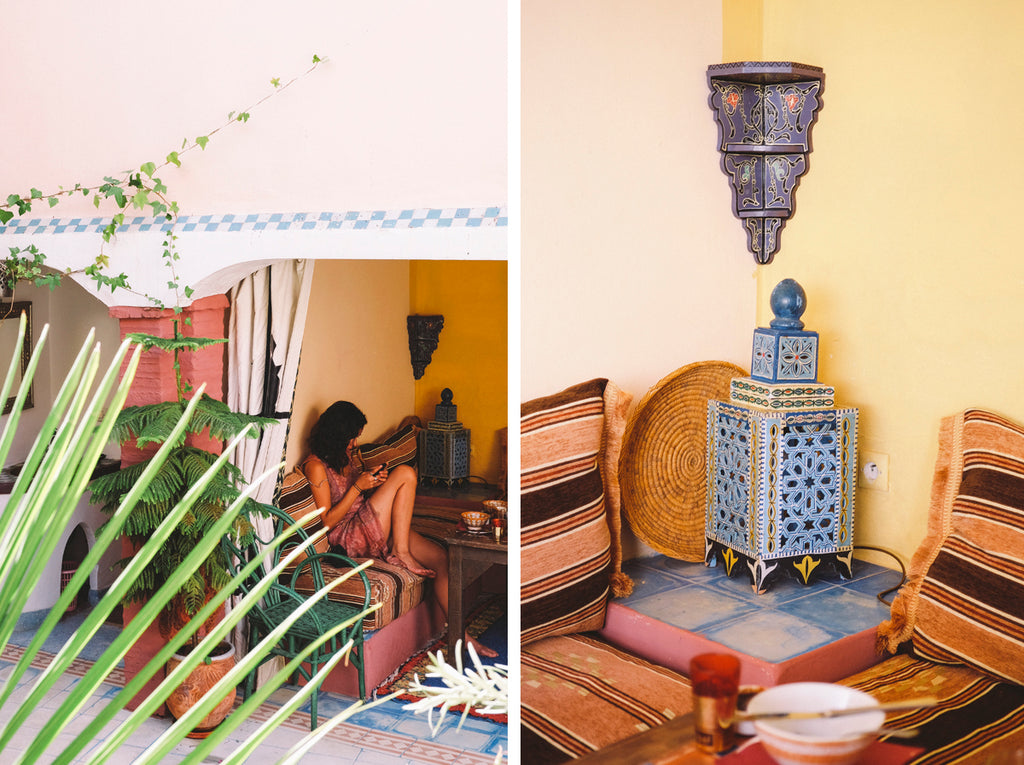
DAY FIVE
CASCADES D’AKCHOUR (CHEFCHAOUEN)
At breakfast we made friends with two other travellers staying at Dar Gabriel and split a return taxi between four to the Cascades D’Akchour waterfall for 100dh each. The drive takes about an hour and the hike up to the waterfall another 45 minutes but it is more than worth every penny and step. The trail is straightforward so you do not need a guide, plus there are many men who seem to pop out from the bushes to stop and ask for directions, though even the most sincerely helpful will probably expect a tip. As we climbed farther up the mountain my head grew lighter and the glittering stream that trickled into view could not have prepared me for the beautiful flood ahead. Arriving at the waterfall was something like entering a scene in a Disney film – the bit where the enchanted mermaid/fairy/siren princess sits on a rock brushing her hair with the teeth of a helpful butterfly – the water rippling so mineral blue.
We found a place to sit under the shade of a pine tree and hungrily peeled the skin of two avocados and a mango bought from the market earlier that morning. The water was freezing to the touch and ran through our veins in the way that only the freshest most freezing water can. The four of us lay by the water and soon realised that we were connected through shared friends back home. Three hours passed and we made our way back down the mountain trail to where an old man had set up shop outside the toilets, selling chocolate snacks melted long ago for 2dh and 6dh for the dusty old pack of Oreos. On the way back to Chefchaouen the taxi passed the women of the mountain busy bunching together branches of herbs – metre long stalks of mint, rosemary or maybe thyme – while their donkeys waited patiently to carry their fragrant loads back down the mountain road to town.

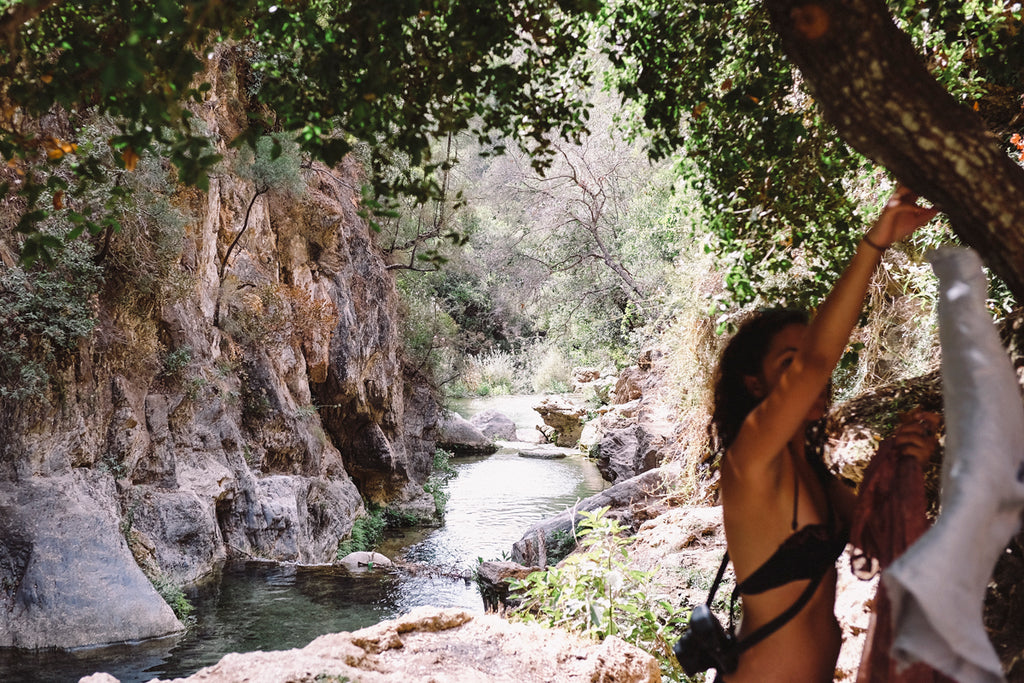
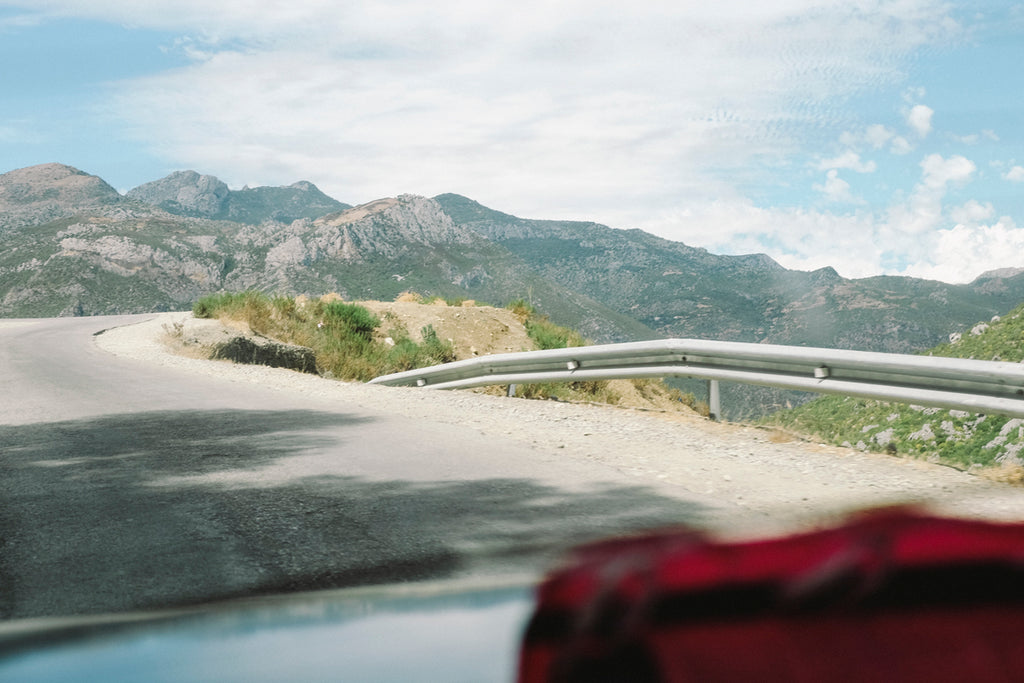
DAY SIX
CHEFCHAOUEN → TANGIER
We stocked up on 2dh pots of crème caramels and caught the evening bus to Tangier. Aside from travelling by foot or donkey, buses are the cheapest mode of transport for getting across Morocco and timetables can be found at ctm.ma (in most cases it’s also worth going to the station directly as more operators will offer alternative schedules). The bus took around three hours and when we arrived toDar Nour – a stunning guesthouse resting at the crown of the historic Kasbah – I sensed the strange duality of feeling both at home and within a place of endless wonder. Dar Nour’s rooftop is sat high above the 11th century ramparts of the ancient medina and, even late at night, the view of the city twinkling beside the blackened bay is breathtaking.


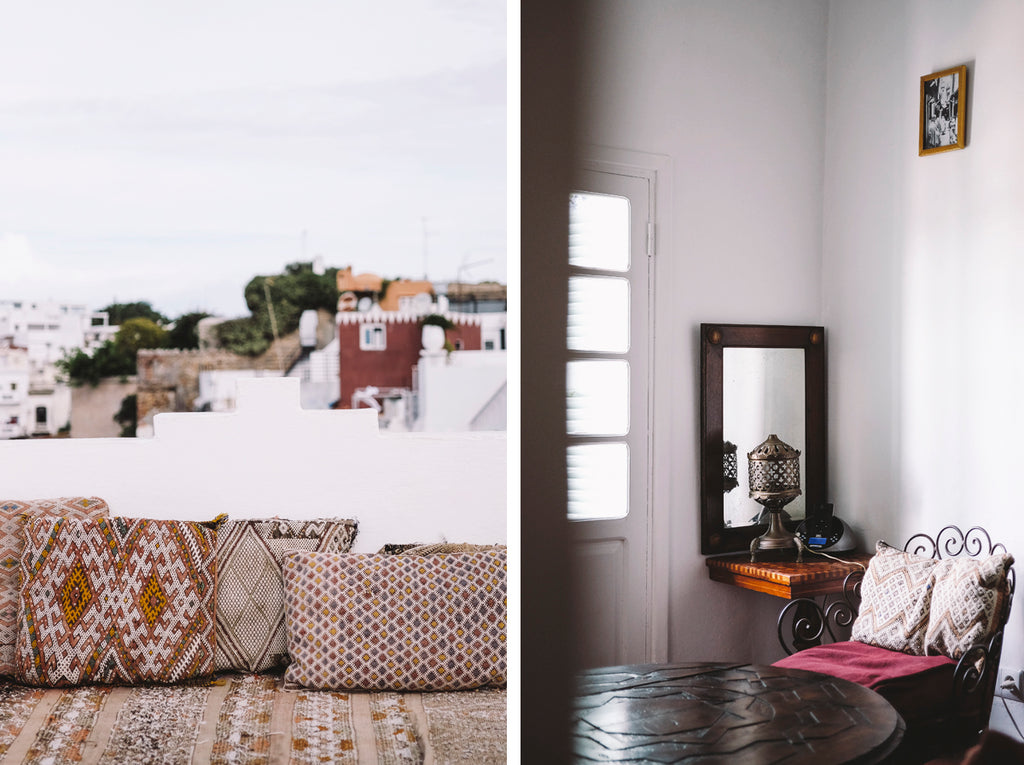
DAY SEVEN
TANGIER
After a perfect breakfast of stewed figs, mango, watermelon, dates, yoghurt, honey, sweet breads, eggs, pancakes and bottomless cups of coffee on the terrace, I left Dar Nour hoping to get lost in the Kasbah. Adrian was already on his flight back home to Spain and as I walked with little direction through Tangier’s sloping streets I could already feel the city colouring me like a stain. I bought an unpolished silver moonstone ring from a Berber jeweller with my last 100dh banknote and the £2.50 I still had in my purse (the Moroccan Dirham is a closed currency so many traders will accept Sterling, Euros and Dollars). I walked down Rue Almohades and all the way down to the port then back up through the market where men and women were selling snails, grapes, corn, socks and a hundred and one other things. I looped up and returned to a beautiful suite that Phillipe (one of Dar Nour’s friendly owners) had kindly moved me into for my last night. Unlike the French word ‘noir’ (black), in Arabic ‘nour’ means light and my sunlit white room at the top of the house embodied its namesake in every sense.
I sat on the terrace at sunset while a woman hung down her washing line on a neighbouring rooftop. Two men scaled some scaffolding surrounding the pillar of the mosque, fixing the broken bell within. At sunset I left Dar Nour via a road I had not been down, hoping to get lost again. At 7.30 I found myself at the Cinematheque de Tanger in time for the evening show for which I paid 25dh to watch Winter Sleep – a Turkish film in French subtitles (rarely on screen long enough for me to attempt translating). Although I did not understand much of the dialogue, going to the cinema in a foreign country is one of my favourite things and this theatre (previously the Rif Cinema) has been standing since 1938 and their diary contains a really good mix of classic, foreign and western cinema. I left the theatre with just enough change left for a 35dh fish tagine along Rue Kasbah, served by a smiling cook who gave me an extra side of sardines and asked me to sign his guest book.
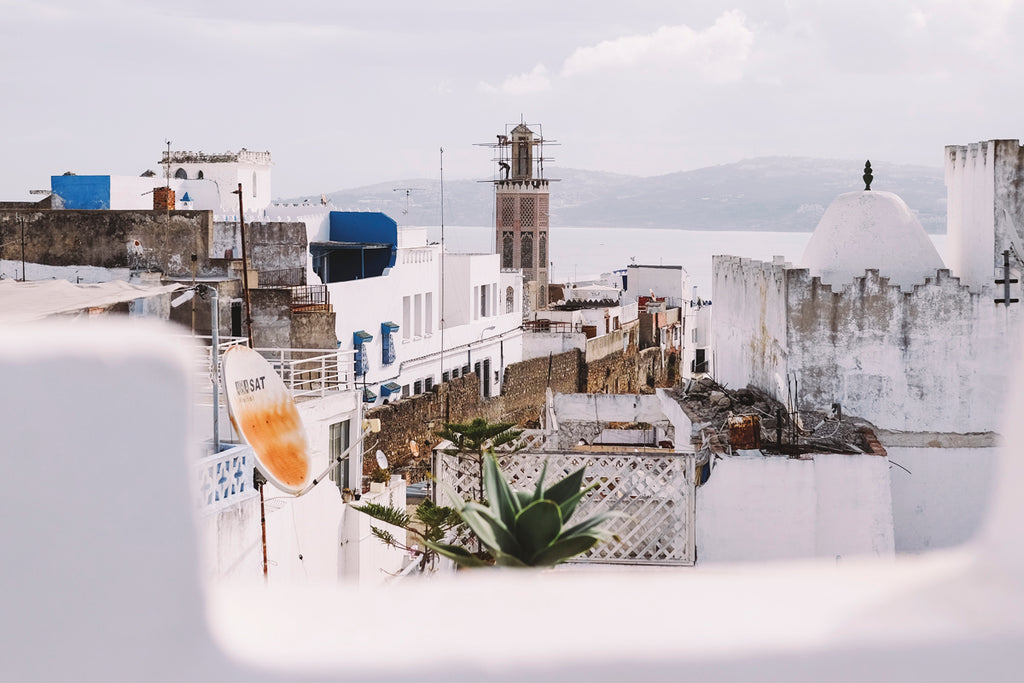


Like most ancient cities Tangier is a place of dualities; it is immediate and hidden, vibrant and veiled, archaic and new. Sat at the very top of Africa in a port that connects the city to both European and ancient Phonecian routes its cultural influences make Tangier a city of endless interest. Like a bug caught in a piece of amber, I was immediately transfixed by the history that surrounded me and had to promise myself I would return as soon as possible. I thought about the route that had brought me here and how it was in fact just a tiny zigzag of the whole country, with Morocco representing only the tip of the Africaberg. In this sense, we barely scratched the surface, but as I sat in the back of a taxi on the way to the airport the next morning and an old man at the entrance to the Kasbah waved goodbye, I knew I would be coming back this way.

My Sunday Somewhere in partnership with Boat Magazine, written by Zara Joan Miller (zarajoanmiller.com), photographs by Adrian Morris aka Mowgli (thisismowgli.com).
